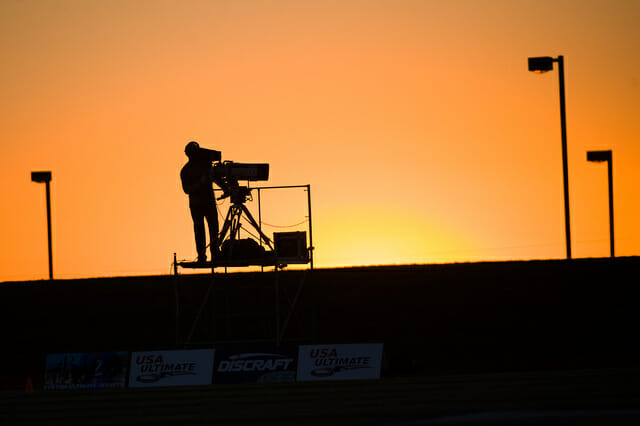More video does not equal more visibility.
August 4, 2017 by Kevin Minderhout in Opinion with 22 comments

On Tuesday, USA Ultimate revealed their live streaming plans for the US Open and the Youth Club Championships. It is, without a doubt, the most extensive media plan for an ultimate tournament revealed to date. But in all its 49 game glory, I find myself asking the same question I’ve been wondering for years: “What’s the point?”
Ever since USAU introduced visibility as its #1 priority and the cost of producing entry level media plummeted, the ultimate community has gone hog wild producing absurd amounts of content not so much with any specific intent but simply because we can.
That USAU carefully selected the word visibility and that we’ve subsequently found ourselves awash in subpar media is not surprising. Visibility makes no judgments on quality.
The goal was never really about creating a spectator-friendly media environment, so much as it was about not having to explain ultimate to the general public. As Tom Crawford often says, visibility via ESPN gets “ultimate on the menu.”
But as a fan of ultimate, I think that this kind of visibility has been incredibly disappointing. We haven’t been telling a very good story. Sports in America are big business not because they simply exist and look pretty, but because they develop compelling narratives and generate emotional connections. American sports fans don’t just pick random games to watch: they pick matchups based on their attachments and associations to players and teams and leagues.
I regularly encounter into this argument that blames the sport of ultimate itself for being unwatchable. Those espousing this view always begin with the false assumption that somehow the visual action that’s taking place on a screen is the deciding factor of whether a potential viewer decides to watch or not. Like if only we could somehow make ultimate a barrage of non-stop action, then finally the fans would materialize.
No one is guiltier of making this fruitless argument than the collective ownership of the American Ultimate Disc League, who decided that unskilled referees and a larger field size would magically bring ultimate to the masses. Where the AUDL has found success, they’ve done so in spite of these changes and not because of them. The Madison Radicals and several other teams have built enviable fan bases because they’ve focused on community, not because the product on the field is superior to club. It’s not.
The game of ultimate is not broken. It does not need fixing. It could probably still benefit from a small tweak here or there, but it’s not holding fans back. Is it immediately accessible to a random stranger? Of course not. Do you immediately understand the rules of Rugby 7s? No. But it has a massive international fan base. It’s enjoyed by kids and adults the world over who appreciate, rather than despise, the intricacies and nuances of the game.
Livestreaming is sports entertainment and, in a crowded media landscape with ever more distractions, if we want to build a gender-inclusive media environment for fans, we need to move our conversation beyond visibility. Because fans aren’t out there looking for the mediocre. They want the best.
We need to start being more judicious in what we cover or at least what coverage we choose to promote. Those of us that watch ultimate regularly are not just ultimate fans or gender-equity fans; we’re sports fan. We want good narrative drama. You can’t tell someone to watch this game or support that coverage because it’s the right thing to do. We need to start telling better stories.
And there are some harsh realities of telling better stories. It’s going to leave some people behind and some feelings hurt. If your team isn’t named Brute Squad, Riot, Fury, or Molly Brown in the Women’s Division this year, it means you probably won’t get featured coverage unless you are doing something unique to stand out. It means if you are a men’s team turning over half your roster, don’t expect a write-up unless it’s to mention that your best player left for Revolver.
And if you’re a mixed team, keep working on stabilizing the division, retaining top players, and building team brands that people care about.
In 2011, when we ran the NexGen Tour for the first time, there was no thought of live streaming ultimate. We wanted to watch ultimate from a high midfield vantage point and we figured that if we could get the games to the fans the following day, that’d be pretty revolutionary. That a few short years later we are inundated with ultimate to watch is a miracle of technology.
As a sport, we are very much in our media infancy, but if we want all this visibility to translate into excitement about the sport of ultimate, we need to start sharpening our storytelling chops. When we start thinking beyond simple breadth of exposure and start weaving together a continuous narrative fabric focused on the teams and individuals that shine on and off the field, that’s when we can really start turning some heads with viewership numbers that matter.